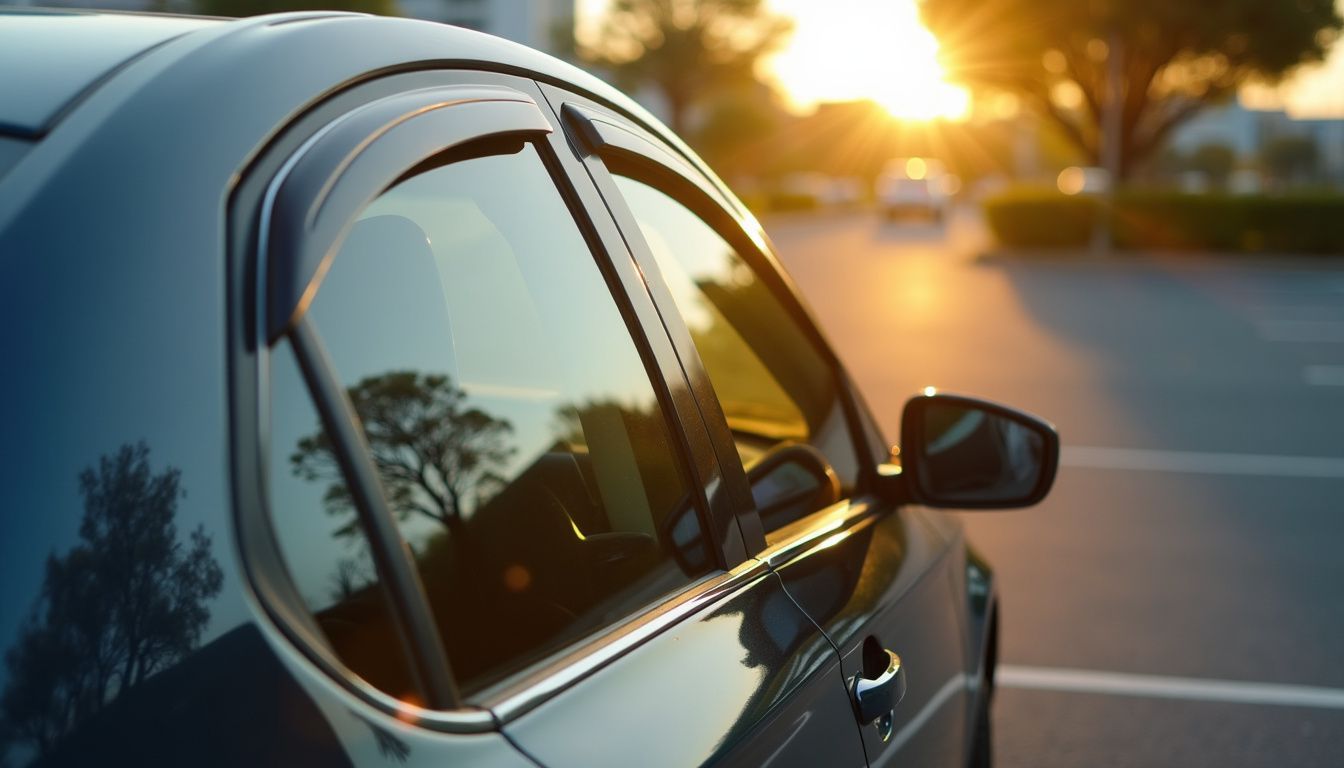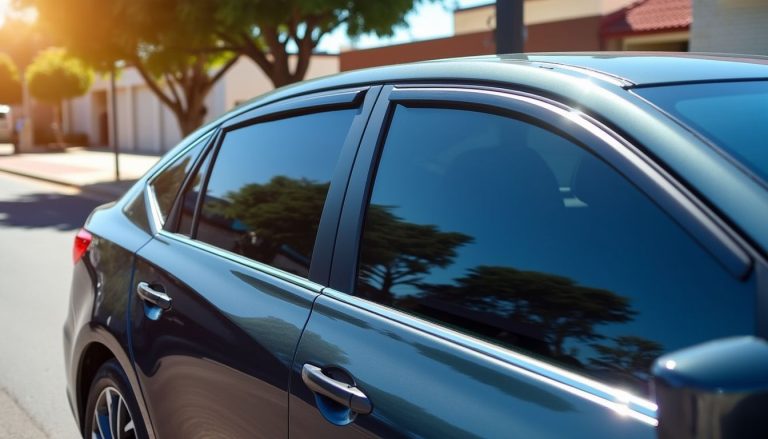How Car Window Tinting Reduces Your Vehicle’s Carbon Footprint in Perth
Understanding Carbon Footprint in the Context of Vehicles
Cars create a lot of carbon emissions. This happens when they burn fuel, and it adds to greenhouse gases. In Perth, like everywhere else, this is a big deal because it warms up the planet.
Now, here’s something interesting: using air conditioning makes cars use about 20% more fuel. That’s right – turning on that cool air in summer does push up your car’s thirst for petrol.
But there’s good news too. Car window tinting can cut down on these emissions by keeping your car cooler without always needing the air con. Tinted windows block solar radiation which helps the inside of your car stay comfortable through all seasons.
Plus, they give UV ray protection, stopping sun damage to your car’s inside bits and pieces and making them last longer. And if you’ve got an electric vehicle in Perth? Well, window tints are even better since they help keep temperatures stable inside your vehicle without draining the battery too much.
What is a carbon footprint?
A carbon footprint is like a shadow our activities cast on the planet. It measures all the greenhouse gas emissions we cause, both directly and indirectly. This includes everything from driving cars to using electricity at home.
Think of it as a tally of how much harm we are doing to Earth with our daily choices.
Vehicles play a big role here. When we drive, our cars burn fuel, which releases carbon dioxide into the air. This adds to our carbon footprint. The more fuel our vehicles use, especially when running the air conditioning system in Perth’s hot climate, the bigger this shadow grows.
Using energy-efficient ways can help make this shadow smaller.
Every gallon of gas your car burns puts 20 pounds of carbon dioxide into the atmosphere.
How does vehicle usage contribute to carbon emissions?

Cars use fuel, and burning fuel makes carbon emissions. Driving cars a lot increases these emissions fast. Each time we start our engines, drive to work, or go for a trip, we add more carbon to the air.
Air conditioning in cars needs more power too. This means even more fuel burn and more carbon emissions.
Tinting car windows can help us use less air conditioning. With tinted windows, cars stay cooler inside. So, they need less air from the cooling system. This cuts down on fuel use and lowers carbon emissions from vehicles.
Now let’s talk about why cutting down on carbon is critical for Perth.
Why is reducing carbon footprint important for Perth?

Perth faces a big problem with climate change. The city needs to fight back by reducing carbon footprints. Less pollution means cleaner air for everyone in Perth. This is good for our health and happiness.
Also, using less energy helps stop the city from getting too hot, especially in summer.
Sustainable actions like car window tinting play a huge part. It saves energy used by air conditioning in cars. This cuts down on harmful gases that cars release into the air. Plus, it keeps car interiors cool so they last longer.
This means we don’t have to replace things inside the car as often, saving more resources.
Using eco-friendly services supports Perth’s green goals too. We all win when we make smart choices to lower our carbon footprint.
Now, let’s talk about what car window tinting really is…
What is Car Window Tinting?

Transitioning from the critical task of minimising carbon emissions in Perth, we now progress to a hands-on solution: car window tinting. This technique involves a slim film placement on the vehicle’s windows.
Its primary objective is to minimise glare, lower heat and provide defence against detrimental UV rays. Tinting service specialists employ environment-friendly films occasionally created from reprocessed materials for an environmental advantage.
Window tinting cools your car and safeguards the interior.
The procedure contributes to keeping the interior temperate and also provides protection for the upholstery against fading. By obstructing surplus sunlight, window tints sustain pleasing temperatures inside your vehicle without overusing the air conditioning.
Reduced air conditioning equates to minimised fuel consumption or energy usage by electric vehicles, rendering tinted windows a wise selection for both comfort and energy efficiency.
What materials are used in car window tinting?

Car window tinting employs several vital materials. Among which, eco-friendly films are notable. These films are distinctive, originating from sustainable practices implying they’re beneficial for our planet.
Also, some tints are fashioned from recycled materials. Indeed, earlier-used objects are repurposed into window tints! This option aids in waste reduction.
Top-notch tints endure for extended periods and function efficiently. They block detrimental UV rays and render the interior of your vehicle cooler. It’s akin to providing your vehicle with sunglasses! Moreover, accredited installers properly manage the disposal of old tints.
They recycle or appropriately discard the utilised materials.
Opting for these types of tints shields your vehicle and also endorses sensible manufacturing methods. By selecting options with proven durability and effectiveness, you contribute to our environment’s protection too.
How does the tinting process work?

To tint car windows, one applies a thin film on the inside. This film blocks harmful UV rays and keeps the car cooler. First, they clean the window to get rid of any dust or dirt. They then cut the film to fit each window exactly right.
Next, using a squeegee, they put the film on the inside of the window. They make sure there are no bubbles or wrinkles for a smooth finish.
Choosing the right type of tint is key for protecting your car’s interior and reducing energy consumption. There are various types available – some offer more UV protection while others focus on keeping your vehicle cool.
Each type affects how much light gets into your car and how it looks from outside. So picking a tint involves thinking about these factors plus legal rules in Perth about darkness levels.
What are the different types of window tints available?

Choosing the right window tint can keep your car’s interior cooler and help reduce your carbon footprint. Window tinting involves applying a thin film to the glass, offering a range of benefits from reducing glare to enhancing privacy. Here’s a look at the different types available:
- Dyed Tint – The most common and affordable type. It blocks sunlight by adding a layer of dye between the film and adhesive. This keeps the interior cooler and offers some privacy.
- Metalized Tint – Uses tiny metallic particles to block heat and UV rays. Besides cooling your car, it makes the windows stronger.
- Hybrid Tint – A mix of dyed and metalized tints. It provides excellent heat reduction without interfering with signals inside your car.
- Carbon Tint – Made from carbon particles that block infrared light well, keeping the interior temperature down without fading over time.
- Ceramic Tint – The top-notch option that uses ceramic particles to reflect heat and UV rays, keeping the interior cooler and protecting against sun damage.
- Crystalline Tint – If you want to lower your carbon emissions without darkening your windows, this is for you. It blocks UV rays and heat while staying almost invisible.
Window tinting can also extend the lifespan of your vehicle’s interior by protecting against sun damage and reduce the need for air conditioning, which helps save on fuel. Next up, let’s see how window tinting impacts fuel efficiency directly.
How Does Car Window Tinting Help Reduce Carbon Emissions?

Car window tinting can assist in reducing the carbon emissions of your vehicle. Tinted windows help in keeping the interior cooler, thereby decreasing the necessity for excessive air conditioning.
As a result, this leads to reduced energy consumption and lower carbon emissions. By lessening the reliance on air conditioning, window tinting provides various advantages, including improved fuel efficiency and a diminished environmental impact.
Moreover, tinted windows provide protection against UV rays, safeguarding the car’s interior from heat damage. This helps preserve the condition of the vehicle’s interior components, reducing the requirement for costly replacements and decreasing the demand for new materials and the energy needed to manufacture them.
Furthermore, there are eco-friendly window films available, crafted from recycled materials, which contribute to sustainable practices while boosting electric vehicle efficiency by maintaining a consistent interior temperature.
This is crucial for battery protection and performance. Thus, investing in professional car window tinting can significantly reduce your carbon footprint and endorse environmental sustainability.
What is the relationship between car window tinting and fuel efficiency?

Car window tinting significantly enhances fuel efficiency. Tinted windows reduce the need for air conditioning, which can increase fuel consumption by about 20%. By blocking solar heat, tinting keeps car interiors cooler in summer and retains warmth in winter, aiding in energy efficiency.
This results in lower reliance on air conditioning, enabling noticeable fuel savings over time. For electric vehicles (EVs), window tinting supports temperature control crucial for battery performance and lifespan.
In summary, through reduced dependence on air conditioning and improved thermal insulation, car window tinting directly contributes to lower fuel consumption and decreased carbon emissions.
This connection highlights the tangible impact of window tinting on enhancing vehicle energy efficiency while reducing environmental harm.
How does window tinting impact the use of air conditioning?
Window tinting reduces the amount of heat that enters your car. As a result, it helps in keeping the interior cooler and decreases the need for excessive air conditioning. Using less air conditioning lowers energy consumption, which then leads to lower fuel usage.
The Department of Energy states that using a car’s air conditioning can increase fuel consumption by around 20%. This means that window tinting doesn’t just keep your car cool but also has an impact on reducing carbon emissions.
Tinted windows act as a barrier to reduce the risk of injury and offer better UV ray protection for vehicle interiors, leading to decreased costly repairs. Overall, window tinting contributes to reducing energy use and lessening a vehicle’s carbon footprint while simultaneously providing benefits such as enhanced privacy and reduced glare.
Can window tinting extend the life of your vehicle’s interior?
Moving from the impact of window tinting on air conditioning to its effect on vehicle interiors, it’s clear that window tinting is vital for preserving and protecting a vehicle’s interior.
Applying window tints acts as a shield against harmful UV rays, thereby reducing the heat absorbed by the car’s interior. This not only keeps the interior cooler but also helps prevent fading and degradation of materials such as upholstery, dashboard, and other components exposed to sunlight.
Window tinting is an effective way to maintain a comfortable and well-preserved vehicle interior. By minimising heat absorption and protecting against UV rays, it reduces the wear and tear caused by prolonged exposure to sunlight.
As a result, there’s less need for frequent repairs or replacements of interior components, contributing to extending their lifespan. This leads to decreased demand for new materials, aligning with sustainable practices and reducing environmental impact – an essential consideration in today’s eco-conscious automotive landscape.
Benefits of Car Window Tinting Beyond Carbon Footprint Reduction
Car window tinting offers more than just lowering your carbon footprint. It improves fuel efficiency by keeping the interior cooler, reducing the need for air conditioning. The tint also shields from UV rays, protecting your car’s interior and enhancing driving comfort.
Furthermore, window tinting can extend your vehicle’s battery life in electric cars, contributing to energy efficiency.
The benefits of car window tinting go beyond environmental impact. It reduces reliance on air conditioning, provides UV protection for interiors, and increases electric vehicle efficiency – all while improving overall driving experience.
So it’s not just about going green; it’s about enhancing your vehicle’s performance and longevity too.
[How to Choose the Right Window Tint for Your Vehicle?]
What are the health benefits of using window tints?
Window tints offer health benefits:
- Protects against harmful UV rays, reducing skin exposure and related health risks.
- Maintains a comfortable interior temperature, reducing heat stress for passengers.
- Enhances driver visibility by reducing glare, promoting safer driving conditions.
- Supports sustainable practices through the use of eco-friendly window films, benefiting overall environmental health.
Consider these when you’re thinking about the health benefits of using window tints.
How does window tinting improve driving comfort?
Driving in a car with window tinting makes it more comfortable. Tinted windows help to keep the inside of the car cooler, especially during hot days. This means you don’t have to rely too much on air conditioning, which saves energy and lowers fuel consumption.
Using air conditioning can make your vehicle use up to 20% more fuel! Moreover, window tints protect the interior from sun damage and shield against UV rays. They also provide privacy, making you feel safer while driving.
By reducing glare and regulating temperature, window tinting significantly enhances driving comfort during long journeys or sunny days. It reduces the need for excessive heating or cooling systems and improves overall visibility by reducing eye strain due to harsh sunlight.
What are the privacy and security advantages of car window tinting?
Car window tinting offers various privacy and security advantages:
- Tinted windows make it difficult for outsiders to see inside the vehicle, enhancing privacy and deterring potential thieves.
- Reduced visibility into the car obscures valuable items from view, contributing to vehicle security.
- Window tinting reduces glare from the sun, improving driver visibility and safety.
- It maintains a level of discretion that can protect passengers from unwanted attention or intrusions.
- The added layer of protection can enhance the feeling of safety and security while travelling in the vehicle.
This helps create a safer and more secure driving experience for both you and your passengers.
How to Choose the Right Window Tint for Your Vehicle?
When choosing the right window tint for your vehicle, there are several factors to consider. First, think about the level of privacy you want; darker tints provide more privacy, while lighter tints still block UV rays.
Quality matters too; go for high-quality options that offer UV protection and heat rejection. Eco-friendly materials made from recycled materials support sustainable practices.
Also, make sure the chosen tint maintains a consistent interior temperature for better energy efficiency and protects against UV damage to extend your vehicle’s interior lifespan. Always hire certified installers to ensure proper installation and responsible disposal of old materials.
Finally, check local regulations on tint darkness and reflectivity before making a final decision.
What factors should you consider when selecting window tint?
When selecting window tint for your car, take the following factors into consideration:
- Local Regulations:
- Check the permitted tint darkness as per local laws.
- Ensure adherence to legal tint limits to avoid fines or penalties.
- Purpose of Tint:
- Determine if you desire the tint for privacy, UV protection, or aesthetics.
- Consider your specific objectives for tinting your windows.
- Budget and Quality:
- Set a budget for the window tints that meets your needs.
- Choose high-quality tints for UV protection, heat rejection, and longevity.
- Vehicle Color and Visibility:
- Evaluate how different tint shades will complement your vehicle’s color.
- Keep visibility in mind to ensure safety and functionality, particularly at night.
- Professional Installation:
- Engage certified installers to ensure proper disposal or recycling of old tint materials.
- Choose professionals with expertise in installing tints customised to meet your vehicle’s needs.
- Tint Material:
- Assess different material options such as ceramic, carbon, or dyed films.
- Understand the advantages and disadvantages of each type of material for optimal performance.
- Heat Rejection and UV Protection:
- Prioritise tints that offer significant heat rejection capabilities.
- Seek tints that provide high UV protection to safeguard yourself and your car’s interior from sun damage.
- Durability and Warranty:
- Select tints that come with warranty coverage against peeling, bubbling, or fading.
- Opt for durable materials that can withstand daily wear and tear effectively.
- Aesthetic Appeal:
- Choose a tint shade that enhances the overall look of your vehicle while serving its intended purpose.
- Strike a balance between practicality and personal preferences to achieve both functionality and style in your choice of window tinting.
This information will guide you in making an informed decision when selecting window tinting for your vehicle.
Are there legal regulations regarding window tinting in Perth?
Considering the legal regulations in Perth, window tinting laws outline the allowable darkness levels for vehicles. It is important to abide by these laws to avoid fines and ensure road safety.
The rules specify the maximum visible light transmission (VLT) percentage that window tints should adhere to. These regulations vary based on different vehicle types, such as sedans, SUVs, and trucks.
Window tinting providers in Perth are well-versed with these legal requirements and can offer guidance on selecting compliant tints for your vehicle.
These regulations are crucial to follow because non-compliant tints can result in penalties or even refusal of registration for your vehicle. Compliance contributes to overall road safety by ensuring sufficient visibility for drivers and pedestrians alike.
How can you ensure a professional installation of window tint?
You can ensure professional installation of window tint by following these steps:
- Seek out certified installers who have a good reputation and positive customer reviews to ensure quality work.
- Verify that the chosen installer complies with local regulations and disposes of old window tint materials responsibly.
- Select high-quality window tint for durability and energy efficiency, ensuring enhanced performance.
- Confirm that the installation process maintains a consistent interior temperature, enhancing comfort and efficiency.
- Consider using eco-friendly window films produced through sustainable practices to reduce environmental impact.
- Request a warranty for the installation to guarantee quality and longevity, providing peace of mind for the investment.
These steps will help you secure professional installation of window tint for your vehicle while also contributing to reducing your carbon footprint in Perth.
Conclusion: Is Car Window Tinting Worth It?
Car window tinting is a simple way to reduce your vehicle’s carbon footprint. It helps keep your car cooler, reducing the need for air conditioning and lowering energy consumption.
Tinted windows also protect your car’s interior from sun damage, extending its lifespan and reducing the demand for new materials.
In addition to reducing carbon emissions, window tinting offers other benefits such as UV protection, which safeguards your car’s interior. Choosing eco-friendly films can further promote sustainable practices in window tint production.
Considering these advantages, it’s clear that car window tinting is worth it – not just for cutting emissions but also for protecting your vehicle and contributing to a more sustainable environment in Perth.
What are the long-term savings associated with window tinting?
When you get your car windows tinted, it’s not just about the looks or privacy. Window tinting can actually save you money in the long run. Here’s how: First, it reduces your reliance on air conditioning by keeping the interior cooler, which leads to lower fuel consumption and carbon emissions.
Second, it protects your car interiors from UV damage, prolonging their lifespan and reducing replacement costs. Third, eco-friendly window films are available, produced through sustainable practices and often from recycled materials.
Moreover, maintaining a consistent interior temperature improves energy efficiency for both combustion engine and electric vehicles. Furthermore, window tinting enhances privacy while reducing the risk of theft and saving on replacement or repair costs.
All these benefits add up to significant long-term savings by minimising energy consumption and contributing to a reduced carbon footprint.
How can you measure the impact of tinting on your carbon footprint?
Measuring the effect of tinting on your carbon footprint involves comparing your vehicle’s fuel efficiency and air conditioning usage before and after tinting. Track your gas mileage or use an app to monitor it for a few weeks before tinting and after.
Measure the amount of time you use your air conditioning during driving pre- and post-tinting, using simple note-taking methods. Consider other factors such as the longevity of interior materials due to reduced sun exposure, which can also contribute to carbon footprint reduction.
Furthermore, examine professional studies that have quantified how window tints impact fuel consumption and AC usage in vehicles similar to yours. Look for reviews or assessments from reliable sources that detail the energy-saving benefits observed by car owners who have installed tints.
This research will provide insight into the potential reduction in greenhouse gas emissions resulting from window tint installation, helping you comprehend its environmental impact more clearly.
By collecting these data points, you can get a comprehensive view of how window tinting influences your carbon footprint without relying solely on personal observations.
What steps can you take to further reduce your vehicle’s carbon footprint in Perth
To further lower your vehicle’s carbon footprint in Perth, consider installing high-quality window tints to reduce the need for air conditioning, thereby cutting down on fuel consumption.
Opting for UV-protective tinted windows helps maintain a cooler interior temperature during hot weather and warmer conditions in winter, minimizing the reliance on heating and cooling systems.
By using eco-friendly materials for window tinting, you can contribute to sustainable practices and environmental conservation while maximizing heat rejection and UV protection.
Another step you can take is choosing window tints that offer significant benefits beyond reducing carbon emissions. Look out for those that provide paint protection, improve driving comfort by reducing glare, enhance privacy and security, and bring health advantages such as reducing eye strain due to improved visibility.
Furthermore, ensure a professional installation of your chosen window tint to guarantee its effectiveness in enhancing energy efficiency. By exploring these steps related to car window tinting along with other measures like regular maintenance and eco-friendly driving habits, you can substantially minimize your vehicle’s carbon footprint in Perth.
FAQs
1. How can tinting my car windows help lower my carbon footprint in Perth?
Window tinting is a simple yet effective way to improve your vehicle’s energy efficiency. It helps keep the interior cooler, reducing the need for excessive air conditioning use and thus lowers your energy consumption.
2. What are some benefits of professional window tinting services?
Professional window tinting offers a range of benefits, including reducing glare for better visibility and reducing eye strain, protecting your car’s interior with paint protection film, and even saving you money by improving energy efficiency.
3. Can window tinting really save me money?
Absolutely! By helping to cool your car quicker, it reduces the amount of time you need to run your air conditioner. This leads to less fuel usage which not only saves you money but also contributes to lowering your carbon footprint.
4. Does window tinting offer any safety advantages?
Indeed it does mate! Window tinting shields from harmful UV rays and also provides an added layer of protection by reducing the risk of injury from shattered glass during an accident.
5. Is there a legal limit on how dark I can have my windows tinted in Perth?
Yes, there is what they call “darkest legal tint” that varies depending on where you live so make sure to check up on local laws before making an informed decision about choosing the right car window shade!
6. How do I get started with getting my car windows professionally done?
Just give us a ring today at our commercial window service center in Perth! We’ll guide you through all aspects of auto-tinting so that we can discover together how this simple procedure will reduce glare, protect interiors and importantly contribute towards lowering our collective carbon footprints.







